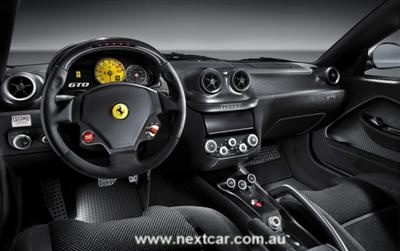Ferrari's new GTO
|
|
|


 Just a few Ferrari 599 GTOs are
Just a few Ferrari 599 GTOs are
expected to arrive locally in 2011.
|
|
|
Home >
News >
Ferrari
8th April, 2010
The new Ferrari 599 GTO is an extreme V12 berlinetta developed
to a specific performance-oriented brief. The 599 GTO is, in fact, the company’s fastest ever road car. It is
a limited edition which is a completely new concept, albeit inspired by a production car. In fact, the 599
GTO is based on the 599XX, the advanced experimental track car, and can be considered almost a road-going
version.
The Ferrari 599 GTO is reserved for just 599 clients who seek the maximum expression of high performance
driving. The 599 GTO benefits directly from the technological transfer from racing and set a record lap time
at Fiorano in 1’24”.
The Fiorano lap time provides just one indication of the potential of this car. Just as significant are the
technical specifications – 670 hp in a 1,495 kg car represents a weight-to-power ratio of just 2.23 kg/hp,
and ensures a 0-100 km/h acceleration time of just 3.35” as well as a top speed of over 335 km/h.
Fundamental to the GTO’s performance is the innovative approach to chassis development which, for the first
time on a production car, saw the integration between a handling set-up tuned for a level of responsiveness
that is close to the limit and highly sophisticated electronic controls. The result is the almost complete
absence of understeer and a truly communicative chassis.
As is Ferrari’s policy, every new Ferrari features new solutions for a road car. Thus the 599 GTO is
equipped with the latest, second-generation carbon-ceramic brakes which are lighter and offer better
performance, new aerodynamic innovations, such as the wheel doughnuts which increase aerodynamic efficiency as
well as improve brake cooling, and the Supersport tyres developed by Michelin include a wider front
tyre for greater roadholding. The driver-car interface is also new with the adoption of the Virtual Race
Engineer (VRE) which provides the driver with instantaneous information on performance.
The Ferrari 599 GTO’s more aggressive character is also apparent in a number of styling elements that
recall the 599XX and from the powerful sound of the V12.
The GTO (Gran Turismo Omologata) monicker instantly calls to mind two Ferraris that have entered the
collective imagination as symbols of performance. After the 1962 250 GTO, which swept the boards in GT racing
categories in the 1960s and is now a highly prized collector’s car, came the iconic 1984 GTO, which
contributed to the development of the modern super car genre.
A preview for a small number of Ferrari clients will be held on 14th April in Modena (Italy), then an
appearance of the Ferrari 599 GTO is scheduled for the Beijing Motor Show (China) at the end of April.
Ferrari 599 GTO Technical Contents
ENGINE AND GEARBOX
The Ferrari 599 GTO’s engine is directly derived from the 599XX unit implementing, however, the necessary
modifications for road-going homologation. It thus complies with Euro 5 and LEV 2 standards. The 5,999 cc
65-degree V12 engine punches out 670 CV at 8,250 rpm with maximum torque of 620 Nm at 6,500 rpm and there is
a smooth, constant rush of power all the way to the redline with no loss of flexibility even at medium and
low revs. This result was obtained by working on the fluid-dynamics and components to reduce internal
friction and by adopting, amongst other things, the 599XX’s redesigned crankshaft. The car also has a
racing-type intake system with a new manifold with diffuser-type intake geometry and short inlet tracts
designed to improve power delivery at high revs and reduce losses. To maximise volumetric efficiency per
cylinder, a connection between the two plenums at the front compensates for variations in the volume. This is
how the engineers managed to achieve maximum performance at high engine speeds. The engine sound inside the
car is carefully controlled to balance the intake sound with the exhaust, which features a 599XX derived
6-into-1 manifold.
The 599 GTO features the same, lower 60 ms shift times and the possibility to make multiple downshifts as
on the 599XX. Despite the increase in power over the 599 GTB Fiorano, fuel consumption and CO2 emissions both
improve slightly to 17.5 km/l and 411 g/km respectively.
VEHICLE DYNAMICS
One of the most significant innovations on the Ferrari 599 GTO is the close correlation between the chassis
set-up, which is close to the handling limit, and the input from the electronic controls which are developed to
increase overall levels of performance.
Since the very earliest states of the two cars’ development, Maranello’s engineers worked to ensure that
these two areas of the car would be seamlessly integrated thus pushing responsiveness to the limit. The result
is, of course, driving involvement as well as faster lap times. Apart from new springs and a stiffer rear
anti-roll bar, the car also features a second generation magnetorheological suspension control system (SCM2).
The suspension works in tandem with the VDC (Vehicle Dynamic Control) and latest-generation F1-Trac traction
control. This makes the car responsive to driver inputs - thanks in part to the adoption of a very direct
steering ratio – but also very stable under braking, sharper on turn-in, more precise in cornering and quicker
out of corners.
WEIGHT REDUCTION
The 599 GTO inherits much of the development work - using the same principles as employed in F1 - that went
into making the 599XX such an extreme performance car.
Reducing weight was a vital objective and the result was the widespread use of composites and components
manufactured with technologies more akin to racing specifications. The areas involved include the bodywork and
greenhouse (with thinner gauge aluminium and thinner glass), the brakes, transmission and exhaust system. The
result is a dry weight of 1,495 kg (close to that of the 599XX with liquids, but less petrol), and a
weight-to-power ratio of just 2.23 kg/hp, a very significant figure that underlines the GTO’s performance
potential.
AERODYNAMICS
The 599 GTO’s aerodynamics have benefited significantly from Ferrari engineers’ experience in F1 and with
the 599XX which allowed downforce to be greatly increased without impacting on drag. Thanks to solutions
transferred from the track car to the road-going version, the GTO generates downforce of 144 kg at 200 km/h.
The entire car was honed, including the front, the sides, the flat underbody and cooling flows. In the latter
instance, the GTO can count on improved ducting to the brake discs and pads, and the adoption of wheel
doughnuts – a disc positioned outside the brake disc that ensure that hot air exiting the wheelarch stays as
close to the body of the car as possible to reduce drag.
|
|
|

Self-Catering Holiday
Accommodation in
Denmark, WA
..... more
|
|
|
Work on the nose of the car was aimed at reducing the width of the wake generated by the front and thus
reduce drag. The front spoiler incorporates a separate lower wing that increases downforce at the front of
the car and increases the flow of cooling air to the oil radiator. On the flanks there’s a new sill design
with a more pronounced leading edge that improves the efficiency of the central section of the underbody.
The underbody itself incorporates a new, lower front section with diffusers ahead of the front wheels to
optimise downforce, and a new double-curve rear diffuser.
WHEEL RIMS AND TYRES
Here the difference in size between the front and rear tyres has been changed. The GTO’s front tyres are
now 285/30 on a 9.5" channel with 315/35 on an 11.5" channel at the rear. The 599 GTO has 20" rims. Roll
rigidity is greater at the rear to minimise understeer. These solutions guarantee improved lateral grip and
quicker turn in.
BRAKES
Once again, experience with the 599XX proved fundamental in honing the new car’s Brembo braking system
because of the highly specific development work carried out on the former on very demanding circuits. The
new CCM2 braking system is lighter and even more consistent in high performance situations. Its consistent
coefficient of attrition meant that the ABS could be calibrated to a particularly high performance level,
further reducing lap times, thanks to improved deceleration and shorter stopping distances. In fact, the
Ferrari 599 GTO boasts an excellent 100 to 0 km/h braking distance of just 32.5 metres. As well as their
role in improving aerodynamics, the Formula 1-derived wheel doughnuts also improve braking efficiency by
optimising brake cooling.
CAR-DRIVER INTERFACE
The car-driver interface was designed to maximise car and driver performance with a layout of the main
commands that ensures absolute efficiency and minimum distraction. The Racing manettino also puts the
emphasis firmly on sporty, track specific driving settings by offering the driver full choice with regard
to the electronic control parameters. The ICE position on the Ferrari 599 GTB Fiorano has been replaced by
CT-Off (traction control off). The GTO is also fitted with bespoke, longer carbon-fibre F1 paddles for
easier use in high-speed driving. In addition, the GTO also features the Virtual Race Engineer, a system
that monitors the status of the car and gives the driver immediate visibility of vehicle performance.
Ferrari 599 GTO technical specifications
DIMENSIONS AND WEIGHT
| Length |
4,710 mm (185.4 in) |
| Width |
1,962 mm (77.2 in) |
| Height |
1,326 mm (52.2 in) |
| Wheelbase |
2,750 mm (108.3 in) |
| Front track |
1,701 mm (67.0 in) |
| Rear track |
1,618 mm (63.7 in) |
| Dry weight* |
1,495 kg (3,296 lbs) |
| Kerb weight* |
1,605 kg (3,538 lbs) |
| Weight distribution |
47% front – 53% rear |
| Fuel tank capacity |
105 litres (27.7 US gallons/23.1 imperial gallons) |
| Boot volume |
320 litres (11.3 cu ft) |
ENGINE
| Type |
V12 – 65° |
| Bore & stroke |
92 x 75.2 mm (3.62 x 2.96 in) |
| Unitary displacement |
499.9 cc (30.51 cu in) |
| Total displacement |
5,999 cc (366.08 cu in) |
| Compression ratio |
11.2:1 |
| Maximum power |
500 kW (670 CV) at 8,250 rpm |
| Maximum torque |
620 Nm (457 lbs/ft) at 6,500 rpm |
GEARBOX
F1 6–speed + reverse
SUSPENSION
SCM2 – Magnetorheological Supension Control
TYRES
| Front |
285/30 ZR20" |
| Rear |
315/35 ZR20" |
CARBON-CERAMIC BRAKES
| Front |
398 x 38 mm (15.7 x 1.5 in) |
| Rear |
360 x 32 mm (14.2 x 1.3 in) |
ELECTRONIC CONTROLS
| CST with F1-Trac |
Traction and stability control |
| TPTMS |
Tyrepressure and temperature monitoring system |
PERFORMANCE
| Maximum speed |
over 335 km/h (over 208 mph) |
| 0-100 km/h (0-62 mph) |
3.35 sec |
FUEL CONSUMPTION
| Combined cycle (ECE)* |
17.5 l/100 km |
CO2 EMISSIONS
| Combined cycle (ECE)* |
411 g/km |
*European version
|